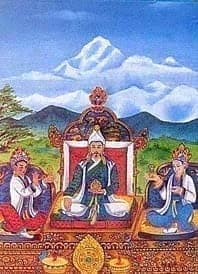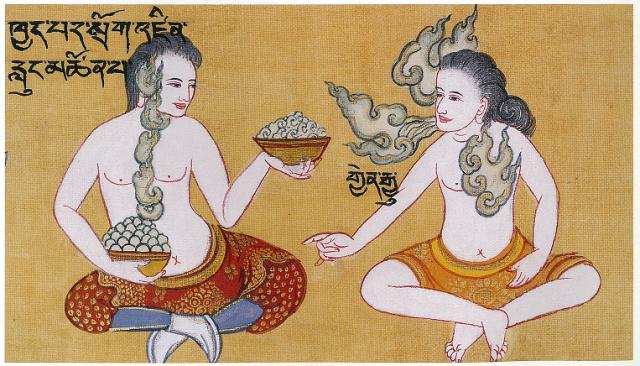Some Thoughts on the Relationship of Buddhism & Tibetan Medicine

Tibetan Medicine: Dharma and Medicine in Tandem
Tibetan medicine as a healing modality is unique in its marriage of dharma and medicine. The root cause of all disease is believed to arise from ma-rigpa or ignorance. It is said that it is only due to our ignorance, the fact that we haven’t perceived the selfless quality of our inherent Buddha nature that we are in a samsaric human body. And it is the qualities of greed, hatred and delusion (desire, aversion, ignorance) that correspond to the three basic energies in our body.
These energies are called the three nyéspa of rlüng, tripa, and béken and correspond in that order to desire, aversion and ignorance. Having a samsaric body means that we automatically have the three nyes pa which are considered the ‘long distance’ or remote causes of illness. When our bodies are in balance then our health is good. Tibetan medicine compares the healthy body to a river of crystal clean water that flows freely and from which all beings can drink. When the nyes pa are out of balance, we suffer from ill health.

Balance in Tibetan Medicine
By practicing the dharma we can begin to balance our tendencies towards greed or desire, hatred or aversion, and delusion or ignorance. We begin to become aware of our thoughts and motivations and to bring to bear some effort towards change. By working with our mind, we develop some inner balance and this, in turn, is reflected in our bodily health and well-being and also in our ability to be of benefit to others.
Tibetan Medicine: A Brief History
Tibetan medicine is based on the theory of the 5 elements of earth, water, fire, air and space and the 3 nyéspa previously mentioned. It combines influences from India, China, Persia, and Greece, as it absorbed medical knowledge from all along the Silk Route. In the 7th century the 33rd Tibetan king, Songtsen Gampo (617-650 CE) invited medical practitioners from around the world to come to Tibet and share their knowledge with local medical practitioners. Influences from these interactions created a local medical culture and a new body of translated medical texts influenced by these various medical traditions as well as that of indigenous Tibet.

A hundred years later, King Trisong Detsen (742-797 CE) invited Padmasambhava and other Buddhist masters to Tibet and cemented Buddhism into Tibetan culture. During that time, he invited the most renowned scholars from the major medical traditions influencing Tibet to Samye. This was perhaps the first international medical conference in the world where such a diverse group of medical practitioners came together, worked and shared and debated knowledge for months. Physicians best demonstrating their knowledge and skill from the conference were asked to stay in Tibet. These experts then contributed to a comprehensive medical system that became the initial development of Tibetan medicine.
Menpas
Practitioners came to be known as Menpas. It is said that Yuthog Yonten Gonpo the Elder (708-833 CE), one of the first and most famous Tibetan Menpa, received the Four Tantras in a dream from the dakinis. And when he awoke he was retained it fully in his mind. Yuthog Yonten Gonpo the Younger, his descendant, is said to have written down the text in the early 12th century.
Tibetan medicine and Tibetan Buddhism are intricately entwined and the mind/body connection that is so prevalent in Buddhism is directly reflected in Tibetan medicine. Many of the commentaries over the centuries were written by high lamas who were also trained as Menpas. Buddhist yogis who spent years meditating in caves also added their knowledge of the subtle channels and energy flows in the body to the body of medical literature. The consequence of directly connecting mind and body results in a comprehensive system that understands the interplay of mind and phenomena to both create and to cure imbalance or disease.
Mind and Body Co-Influencers
Not only can the mind influence the body but the body can also influence the mind. Tibetan medicine explains the effects of the seasons on our body as well as the environment in which we live. Moreover, it makes very specific and practical recommendations in diet and behavior to bring balance to our system. For instance, in cold, windy seasons and environments the rlüng nyéspa can become disturbed. Thus, eating warm, oily, smooth foods and keeping our bodies and especially our head warm and covered will counteract these influences.
Tibetan herbs are very helpful for bringing balance in the body/mind. Thus, they can relieve many common disorders like insomnia, depression, and anxiety. Likewise, the external therapies such as Tibetan kunyé (a form of massage) and hormé (warming specific points) are extremely relaxing and calming to the system. Sometimes just getting a really good, relaxing massage is just what we need for an attitude adjustment!










Responses
[…] Tibetan Medicine: An Introduction […]